 |








  
|
 |
 |



SIX 21st CENTURY CHINESE NEO-POP ARTISTS
Liu Yan | Kang Can | Lu Peng | Li Bo | Yang Na | Xiong Lijun
Virginia Miller Galleries
November 2, 2007 through February 29, 2008
Exhibition Press
Images Checklist

As evidenced throughout art history, what was once deemed radical and undesirable gradually moves into the mainstream through defiant thinking. New generations of artists assimilate and appropriate ideas from previous movements, only to then rebel and push the boundaries of what is comfortable and familiar even further. Twenty-first century China is now in the throes of such a cultural revolution. We are witness to the transition from the initial group of Chinese contemporary artists and their Post-Great Leap style, to the current rise of a new Chinese Neo-Pop visual language.
Similar to the counter-culture that spawned American Pop Art, Chinese social and political issues as well as their overwhelming youth population are the foundations of the 21st Century Neo-Pop movement. Much like America's baby-boom generation that came of age in the 1960s, China's one child generation is breaking ground toward political and personal emancipation. During this time of unprecedented affluence, the cult of media-driven narcissism is reflected in the work of this current group of young artists. This new cultural freedom propels each artist to create fresh images, objects and ideas.
Although Pop Art has been historically associated with Western culture and America in particular, the political, social and artistic magnitude of the current movement continues to challenge this young generation of Chinese artists with similar momentum to forge ahead into unexplored territory.
Pierrette Van Cleve, Curator

LIU YAN
Liu Yan's works combine the materials and techniques of traditional Chinese painting with Western representational modes and imagery. In the six works exhibited here, Liu Yan creates a collage-like painting surface from China's cultural detritus: pages of old books, gold foil, mulberry paper and reproductions of famous imperial portraits of a Qing Emperor and Empress. She then works in a pastiche of imagery and icons from traditional China and contemporary international popular culture, revealing the tensions that lie beneath China's integration into global culture. Rock and roll stars with mohawk hairstyles, punk costumes and spike collars painted in neon colors are juxtaposed with Peking opera actors. Their exaggerated expressions and postures resonate with the masked, elaborately costumed opera figure, erstwhile stars of pre-revolutionary China. The Peking opera actor appears mournful, perhaps witnessing his demise as a cultural icon.
Changing gender roles and sexual desire also figure prominently in Liu Yan's work. Women wearing the dress and chignons of Imperial China are rendered in traditional ink painting technique, their bodies hidden by their flowing robes. By contrast, the bodies of modern-day women are revealed in various states of dress and undress. A Western woman in a short frock and high heels bends over provocatively. A more demurely dressed woman touches the shoulder of a half-naked woman who looks out from behind a Peking opera mask. In Enjoyment in Destruction, a bare-chested woman clutches her breasts and screams, her face bound with rope. All of these images suggest the unleashing of repressed sexual desire. Traditional figures look on, eyes bulging, mouths open in dismay. The highly animated calligraphic line of their robes is evocative of their disturbed emotional state.
In The Man's World and The Woman's World, Liu Yan uses the highly formal mode of imperial portraiture to signify gender roles in traditional China. Supreme emblems of dynastic China's state and society, the Emperor and Empress, are represented frontally and symmetrically seated on elaborate thrones. All traces of their bodies and their sexuality are hidden by imperial robes and headdresses. Their dignified role as exemplars of social decorum and political power is violated by the debauched behavior of the figures around them. Barely clad women straddle the imperial couple's laps. They are surrounded by a rogues' gallery of modern icons of political and cultural power including Mao Zedong and his wife, Jiang Qing, Salvador Dali and Madonna. In The Woman's World, two women in court garb kiss while a female People's Liberation Army soldier aims her gun at the forces of desire that threaten to overwhelm traditional Chinese culture and values.
The layered cultural references and jarring juxtapositions of Liu Yan's work reveal the tensions beneath changing attitudes towards desire and the collision of cultures in a global age.
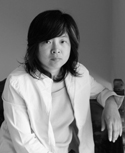
All artists believe that having an artistic "language" of their own is important. After years of practice, finding my personal art language is no longer a struggle. Instead, the challenge comes from finding an artistic "vision." My vision has developed from my attitude, which determines the concept, as well as theme and language. Only after having one's own life experiences, do we truly understand our own visual language. An outstanding work of art is touched by the soul and emotions of the artist, and is developed with their personal perspective. When the artist falls in love with their work, the viewer will understand and appreciate their dedication. -- Liu Yan
|
LIU YAN and ROBERT RAUSCHENBERG
Robert Rauschenberg, the pioneer of the American Pop Art movement, combined diverse objects within his work, allowing for a visual conversation to occur. His artwork cited many contributing factors to the political, social and international changes of the 1960s. Pioneering the Chinese Neo-Pop movement, Liu Yan proposes an alternative to the prevailing mode by using a painted collage technique which weaves popular imagery within ancient scrolls. Her artwork has its own visual dialogue which examines the juxtaposition of past and present societies.
|

KANG CAN
Kang Can's work wryly concerns the assault of the global consumer culture on Chinese society. In this series of paintings, tiny babies are set in absurdly hazardous scenarios: emerging from a towering glass of Coca-Cola, asleep on a smoldering cigarette or popping up from behind two giant playing cards. In most of the paintings, babies smile, laugh and sleep peacefully, oblivious of the danger. In Fast Food III, the danger posed to the most vulnerable members of humanity is brought home: a baby is crushed beneath the weight of a gigantic Big Mac hamburger. Images of Western consumer culture, all of these items are things that are hazardous to our physical and material well-being. Their iconic power is played up by their monumental scale relative to the infants and the hyper-realist painting style.
The artist has described his babies as "symbols of human purity coming into this world simple and unadulterated" whose innocence is gradually destroyed as they become part of contemporary life. Kang Can's babies are also metaphors for China's loss of cultural naivete as it becomes integrated into the international global economy. The historical references to China's tradition, so evident in Lu Peng's work, are nowhere to be seen in Kang Can's paintings. This absence suggests a further anxiety, the obliteration of Chinese culture in the face of Western consumerism.
Babies are universal repositories of humanity's hopes and anxieties for the future. Their symbolic role is intensified in China where a one child per family policy for city-dwellers has been in effect for more than twenty-five years. As a result, children have been revered and spoiled to the point that the generation now being raised is referred to as the Little Emperors. The implementation of the one child policy in 1980 coincided with unprecedented economic growth. Through media outlets like the Internet, television and Hollywood films, Chinese youth today know more about the world beyond their borders than any previous generation. They track the latest international fashion fads and swoon over pop stars from Hong Kong and Taiwan, and as Kang Can's painting indicate, they are the newest consumers for Western fast-food chains. Kang Can's paintings ask this newest generation to consider the physical and psychic danger posed by the ready embrace of globalized consumer culture.

When a new baby comes into this world, it is very pure. When we put the baby into contemporary society, its innocence is lost, creating a whole new reality. The one child society is an overwhelming strain on the Chinese people. The demands projected on each child are intensified by a culture that identifies strongly with its heritage. My paintings deal with the one child generation, which is both full of loneliness and the hope and promise of the future. -- Kang Can
|
KANG CAN and ANDY WARHOL
Andy Warhol and Kang Can both comment on societal issues through the use of a singular image taken from popular culture. Warhol's work elevated people and everyday objects to celebrity status, employing images from pop culture, as opposed to the elitist styles of the Abstract Expressionist movement. Kang Can works against these same pressures, using images from his own popular culture, and fighting the traditional Chinese style to present his own unique vision. Like Warhol, a certain celebrity status is implied through the single figure of a baby, struggling to conquer the larger than life pressures of contemporary society.
|

LU PENG
Born in 1967, Lu Peng is of the same generation as the artists associated with Political Pop and Cynical Realism art movements (Yu Hong, Liu Xiaodong, Fang Lijun, Zhang Xiaogang, Zhang Huan) that emerged in the 1990s. These artists appropriated Western Pop Art, replacing icons of American commerce and mass media with the propaganda posters and films of the Mao era. Their work evokes the disillusionment and cynicism that followed in the wake of the disastrous political movements of their youth like the Cultural Revolution (1966-1976) and Tiananmen Square incident of 1989. Unlike his contemporaries, Lu Peng mines imagery from pre-revolutionary and revolutionary China as well as the consumer-oriented society of the past fifteen years. His paintings are a chaotic assemblage of people and symbols from China's political and cultural history evoking chaos, freedom, optimism and dismay.
In the six-part series, Kung Fu and Fishes, Lu Peng incorporates a hodgepodge of cultural signs associated with Chinese strength and prosperity. Figures dressed in People's Liberation Army uniforms and pre-revolutionary silk pajamas copulate and strike martial arts poses, arms and legs akimbo. Fat fish, peonies and military deities, traditional signifiers of prosperity, fecundity and power, are scattered across a unifying background of a traditional Chinese landscape drenched in red.
The color red is the quintessential Chinese signifier of good fortune, strength and happiness. These positive associations are undercut by the fragmentary assemblage of images, and the dismayed expressions of the figures that populate Lu Peng's paintings. Their entangled legs and arms suggest a chaotic battle. Here the red wash can be surmised as alluding to China's violent and bloody modern history.
In his paintings, Lu Peng adopts the position of dispassionate observer of China's social changes. Like the figures that range unbounded across his paintings, Lu Peng has styled himself as an "unfettered wanderer" of the social, political and cultural fragmentation that has marked China's painful modern history. Art critic, Li Xianting has observed that "Chinese people have been educated to believe in the present and deny the past." In the series Kung Fu and Fishes, Lu Peng recaptures this past as a fragmented memory.
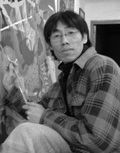
My works show the relationship between people and nature. In China, Kung Fu alludes to an individual accomplishment or cultivated skill. The origins of Chinese martial arts are traced to self-defense and military training. For the Chinese people, who are dedicated to nature, the fish symbolizes freedom. All of my artworks are painted using traditional methods and modern materials. I merge aspects of Tibetan wall painting with my personal style. I challenge the viewer to look closely and to distinguish the difference between the rational and irrational. The content of my work expresses the happiness and hope I have for my culture. -- Lu Peng
|
LU PENG and JASPER JOHNS
Jasper Johns' unique approach to cultural, political and philosophical issues in contemporary society incorporated popular objects and images, presented in a cool and detached way. Lu Peng's highly political works incorporate luscious palettes and beautiful ornamental design. Jasper Johns and Lu Peng render icons, objects and symbols, and play with the ideas of illusion and reality related to the current political and cultural climate. Decades apart, both artists created new artistic and political languages that speak about greater societal issues.
|

LI BO
Much of the work in this exhibition addresses the double-edged sword of China's new openness to international influences, and growing economic and personal freedoms. Li Bo's enigmatic paintings remind the viewer that freedom of expression is limited in the People's Republic of China. Li Bo paints a menu of objects and characters that appear random and unconnected. They are lined up for inspection and interpretation by the audience. Painted in an uninflected, descriptive style and isolated against a non-descript background, disparate objects and people are scaled at the same size and thus assumed to be of equal importance. The images are culled from the Internet, displayed on a tipped-up picture plane. The spotlight illumination invites us to explore and ponder this series as a kind of visual language.
A human heart rendered with anatomical precision, a schoolgirl provocatively posed, a trophy inscribed with the artist's name, a government propagandist broadcasting his message, a red rose in bloom, a bound figure wearing a placard declaring the crime, a syringe, bottle of medicine and a bandage occupy the shelf space in Continue to Look #4. Individually, these images seem to have no particular resonance, but, when considered in relation to one another, their sinister overtones are revealed. The heart, the propagandist and criminal figure allude to the speculation of organ harvesting for the international market. Li Bo often throws in innocuous images as decoys. The schoolgirl in uniform hints at pornography and highlights the uniform as a fetish. The syringe is a symbol of strong medication, the Band-Aid implies a "quick fix." These are things that keep the body politic quiet.
In Continue to Look #3, Li Bo includes several items found in a typical outdoor market: a chained pet monkey, a cricket cage, a pig on a spit. The rest of the images are unsettling: an automatic rifle, an old tooling machine, a religious figure and two men in pajamas with gloved hands and feet, whose right ears are red from constantly hearing the party line. This reminds us that China is still ruled by a Communist government. When considering the objects as a group, they become a metaphor for the looming threat towards a carefully controlled population.
Much like the literati paintings of China's ink painting tradition, Li Bo's works are an encrypted language, reminding us of the anxiety that accompanies artistic commentary.
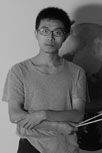
I am part of a new generation of artists in China. I show my work in my own way rather than categorizing it in terms of the previous generation of artists who fell into the temptations of fame and fortune. The Internet is very important to youth these days. All of my images are appropriated from the Internet and reassembled in a systematic way. I choose images that are interesting and important to my message and then make each equal in size. I challenge the viewer to determine what each image means, singularly and collectively. My personal meaning is just one in an endless stream of possible interpretations. -- Li Bo
|
LI BO and WAYNE THIEBAUD
Wayne Thiebaud and Li Bo use their canvases as stages, placing the objects front and center. Their symbols stand firmly, if somewhat ironically, as monuments to consumerism. The objects that span across each of their works evoke a sense of nostalgia and reverence, while commenting on the satirical side of contemporary consumerism. With an absolute focus on presentation, Li Bo spotlights a diverse grouping of objects and figures, all the same size, giving them all the same level of importance. As Pop Art is the movement most noted for the glorification of a single object, the end result is a farcical take on popular culture.
|

YANG NA
Yang Na's paintings caricature the women of sexual fantasy. She depicts them with oversized heads and proportionally tiny bodies. Their feminine features are exaggerated by cosmetic enhancements: false eyelashes and nails, plucked and penciled-in brows, deeply shadowed lids, and mouths colored with glossy red lipstick. Their unlined, perfectly smooth skin has a porcelain quality giving them a doll-like appearance. Their necks are wrapped, almost roped, with gaudy jewelry. Like Xiong Lijun's women, their eyes are huge and glassy but they are not expressionless. Yang Na's women are hyper-sexualized and self-absorbed. In Fate From the Mirror a woman plants a kiss upon her mirrored self and then looks coyly at the viewer. The woman in The Smell of Love deeply inhales a cigarette in the shape of a phallus, her eyes closed in deep enjoyment. Smoke wafts sensuously upward from her open mouth. The perfectly manicured, blood-red nails are claw-like, suggestive of the power of female sexuality. The third painting in the series, A Cup of Yang Na, shows the same character, the alter ego of the artist. She is crying; her eyelashes are drooping and tears are rolling down her cheeks in a steady stream, filling a pair of toy teacups. Emblazoned with hearts, the teacups are a metaphor for the vulnerability and loss of innocence hidden below the glamorous sheen and sexual power.
Yang Na's ideal woman is drawn from a global cultural landscape of mass media and consumption, cartoons, movies, videos, Internet games and toys. The woman in her paintings especially resembles the avatars (the word "avatar" derives from the Sanskrit term Avatara, meaning "incarnation") of online chat rooms and virtual games. As participants in these Internet communities we can create our physical identities by selecting from a menu of features, hairstyles and clothing. With her turned-up nose, blue-black eyes and rouged complexion, Yang Na's alter ego is not identifiable as being from any particular place or having a particular ethnicity. Rather, she is a composite of a commercial visual language of what is considered "sexy" and "trendy." In adopting hyper-sexualized attributes for her physical persona, the real Yang Na can indulge her fantasies about what it might be like to live a more uninhibited life, free from moral strictures and consequences. Unlike Xiong Lijun's relentlessly upbeat images of trendy, youthful consumers, the sobbing alter ego in A Cup of Yang Na forces us to consider what lies beneath.
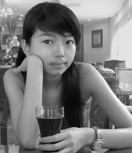
I have been surrounded by art my whole life, even since my birth in a theatre during a performance! When I was three years old my family relocated to Chongqing to work at Sichuan Fine Arts College. For as long as I can remember, the female form has fascinated me, its soft feminine beauty makes me feel at peace. Most of my understanding of the body and its sensuality comes from the rigid training I received from my master artist. Foreign movies have also had a great deal of influence on my work, inspiring "sexy" and "trendy" subjects. -- Yang Na
|
YANG NA and ROY LICHTENSTEIN
Roy Lichtenstein's and Yang Na's interpretation of the Pop movement is a comic mirror of society. Both artists work in a visual language that encompasses music, consumerism and fashion, spotlighting an entire way of life among young people. Taking inspiration from Japanese animation and video avatars, the images projected in Yang Na's paintings are presented with, and sometimes transformed by, the same humor, wit, and irony as the comic renditions of Lichtenstein. Her work, like Lichtenstein's, may be read as both a palpable celebration of and an undeniable critique of popular culture.
|

XIONG LIJUN
The confusion around China's integration into global commercial culture and the tensions underlying unleashed material and sexual desire is a common theme in many of the works in this exhibition. The super trendy girls in Xiong Lijun's paintings also confront material desire in 21st century China. But unlike the older generation of artists, Lu Peng and Liu Yan, whose work uncovers psychological complexities, Xiong Lijun's paintings appear to be an unabashed celebration of consumerism and internationalist pop culture. Her paintings utilize the simple compositional structures and eye-catching colors of the advertisements that litter China's urban landscapes. She depicts fashionably dressed and coifed young women in a flat cartoon style against backgrounds of neon green and hot pink.
Born in Chongqing in 1975, Xiong Lijun and her peers were unaffected the violence and economic deprivation that accompanied the cycles of Maoist political campaigns. Instead, her generation has come of age during a time of economic revolution that has led to a dramatic increase in prosperity for urban dwellers and an unprecedented openness to the global economy and culture. Her art, on the face of it, paints a sunny picture of China's youth raised on a steady diet of fashion magazines, MTV, cartoons and advertising. Her girls strike a pose, skip, dance and joyously splash through pristine water puddles, exuding youthful enthusiasm, optimism and freedom. But upon a second look, one detects an undercurrent of conformism. The young women's clothes are uniformly mismatched and bright, their dance movements appear to be in lock-step, almost robotic. Their eyes are large, in the manner of Japanese anime, glassy and expressionless. The absence of reflection in their eyes seems to suggest a lack of self-reflection, a soullessness. This work is a critique of unquestioned acceptance of commercialism and material consumption. The billboard size canvases, fluorescent hues and cartoon style of Xiong's exuberant youth suggest that these images are more of an advertiser's fantasy, blinding us to the reality of the rural peasants and migrant workers who make up the majority of China's 1.3 billion population. Most continue to live and work in grim poverty with limited access to medical care and education; their livelihood subject to the vagaries of powerful officials. Viewed in this context, Xiong Lijun's girls are reminiscent of the rosy-cheeked youth of the Mao era propaganda posters. Like these posters, Xiong Lijun's paintings proclaim a new era of prosperity and freedom. The cartoon-style of her figures implies that this commercial vision of a new China, like the propagandists' communist vision of her parents' generation, is an unattainable fantasy.
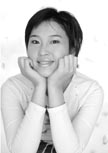
As modern Chinese society blossoms, I am striving to celebrate our coming of age. My work embodies the human spirit and flaunts an unencumbered and carefree individual freedom of expression. We no longer have to endure personal humiliation, senseless sacrifice and stifling suffocation as a way of life. Youth is now united in victory. We enjoy the right to pursue our dreams and use our talents as we choose, to grow and to prosper spiritually. I combine brilliant colors, water, and fluid motion with vibrant content and energetic subjects in large-scale compositions. I believe that our future is bright and cheerful. -- Xiong Lijun
|
XIONG LIJUN and JAMES ROSENQUIST
Rosenquist's quintessential contribution to the Pop movement has always been the billboard. Capturing the over the top marketing that has become so deeply engrained in American culture, and now in Chinese culture, the billboard elevates even the most mundane objects to a spotlighted status. Xiong Lijun, like James Rosenquist, recognizes the power of monumental advertising and works on billboard-sized surfaces, using an audacious palette and domineering figures to absolutely capture the vivacious and carefree attitude sweeping through the market-obsessed youth culture.
|

Expanded Notes: Lydia Thompson, Ph.D., Thompson & Martinez Fine Art Consulting
 |
 |
Van Cleve Fine Art - 2171 India Street, Suite H - San Diego, CA 92101 - phone 619.501.4718 fax 619.338.0826
© 2001 - 2010, Token Art, Inc. All rights reserved. Do not duplicate or redistribute. Copyrights of art on site belong to the artists.
|
|